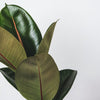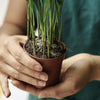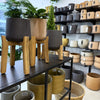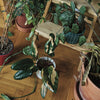7+1 tips on what to do with maids when you go on vacation
Vacation on the horizon…
Heat, summer and holidays - that calls for a vacation or at least a short trip away from home, where you can leave all your worries behind... and your maids too. If you are going somewhere for more than a week, it is advisable to think about your houseplants in advance and properly prepare them for your absence. After all, you haven't lovingly cared for them for days only to come home after your vacation to find them dry and unsatisfied. In this article, we have written 7 tips that you can use to get inspired and equip your home jungle before leaving home so that you return to paradise and not to a nightmare.

1. Topping and shade
It's probably the most basic thing, but no matter if you're going anywhere for longer than 2-3 days, it's a good idea to think about the watering that the plants will need during that time. Therefore, the simplest and most basic recommendation is to water the rooms before departure. How much depends on how long you will be gone. Of course, be careful not to overwater the plants - then instead of drying out, they could suffocate you during the holiday.
A suitable method is watering in a saucer, which can be left full and the plant will gradually absorb the water by itself using its root system. In this way, the plant can survive for less than a week - but it all depends on the amount of water and consumption that the plant has.
To increase the likelihood that the plant will get enough water, place it in the shade. Of course, we don't mean to lock it somewhere in the dark, but if you put it out of direct sunlight, water consumption will be less.
2. Bath in the tub
Another option to keep the bedrooms covered can be using a bathtub or a sink - depending on the number of bedrooms we need to provide. Fill the bathtub or sink with water and line the bottom with towels or tea towels that absorb the water. We place the plants on them (of course, we need to place the plants in pots with holes in the bottom, otherwise the water would not be absorbed). The plants first absorb the excess water and then they will absorb the water and water vapor from the towels. This method will keep the room wet for about a week, but it only applies to bathrooms that have a window, i.e. enough light. Your plants would die in the dark.

3. Self-watering system
If you've already invested in self-watering planters, you've won! You stick to tip one and you're good to go. However, if you don't have a self-watering system at home, you can easily make one.
You can use, for example, a pet bottle or a glass bottle with a narrow neck. You fill the bottle with water and then stick it neck first into the dirt towards the maid so that the bottom of the bottle sticks out upwards. Although it is not aesthetically pleasing, the water will gradually soak into the soil and the plant will be continuously watered for some time.
The use of "flasks" works in a similar way, which you can buy and even find them in different designs. Irrigation flasks will be especially appreciated by aesthetes who like beautiful and at the same time practical things.
In this way, the room plants can last a week without needing to be watered, but it depends on the amount of water and the size of the bottle or flask you use.
4. String self-watering system
You can also use a string made of absorbent material as a self-irrigation system. We also cover part of it in clay and put the other end in a container with water. In this way, the water will seep through the string into the flower pot. However, if you have the time, you can do other and better things with string, such as a full-fledged irrigation system.
To create a self-watering system, you will need a dressing gown, a string (must be of absorbent material) and a slightly larger container (or a container for a flower pot) - ideally, there should be at least a few centimeters of space between the bottom of the pot and the container.
You plant the room plant in a flowerpot with holes in the bottom, while you pull the string through these holes. You will thus have a houseplant planted in a flowerpot, from which the string will stick out from the bottom. Pour water into a container or a larger container and immerse the string in it.
In this way, the room will draw water through the string and stay watered for one to three weeks, depending on the amount of water and its own consumption. You can still use this system by adding expanded clay (or simply pebbles) to the package, which you fill with water. The roots of the plant will naturally stretch behind the water source and can grow through the pot to the container.
5. (Improvised) greenhouse
A greenhouse is always a great helper. However, if you don't have one or all the maids can't fit in there, it is possible to make one from a plastic bag or bag. The greenhouse method is suitable to use if you are going away for a long time or if the plant is used to being watered often and dries out quickly.
You can get plastic bags with an airtight seal or use a plastic bag. The bag must always be larger than the plant itself so that the parts of the houseplant do not touch the bag if possible. We normally water the plant and then close it in a bag, in which it inflates and thus creates a "house" or tent around the plant, which will collect the precipitated water. This way, our room plant can last a week to 14 days.

6. Hydroponics or peat bog
If you're going on vacation tomorrow, you can skip this tip. However, if you have time or want to prepare your plants for a longer trip as a precaution, you can't go wrong with hydroponics or peat moss. You simply water the plants you grow in water or use one of the earlier tips. If you grow the plant in a peat bog, you can also rely on it and its absorption capabilities.
7. Ask for a babysitter
A good old proven way to take care of maids in your absence is to ask someone to look after them for you. It can be anyone from family, neighbors or friends, in short, anyone you can trust. Similar to animals, you can leave them detailed instructions on how often to water or fertilize the houseplants.

8. Additional drainage under the flower pot
If you want to prepare for the long term, you can also use the following method, which may not be suitable for some, but if you don't have too many plants and you have space and enough pots for it, it can help a lot.
Get a larger amount of expanded clay and keep the houseplants in a flower pot with a bottom hole. Place a 5-10 cm deep layer of expanded clay in a larger and deeper flowerpot, which you completely cover with water so that the water ends at the edge of the lower flowerpot in which the plant is located. This measure will cause that, in addition to the moisture that goes directly in the pot from the bottom up, the whole package will also receive "bottom moisture" under the entire pot, and a number of plants will adapt to this to the extent that they will extend a few roots through the hole to the bottom of the pot. from which it will slowly suck up water, even when the substrate in the pot is completely dry. It can prolong the drying of the plant by up to 14 days. It only depends on the amount of water, the size of the pot and the root system of the plant.
We hope that you and your maids are doing well over the summer and that thanks to our tips you won't miss out on any plant happiness!
Tips in the closing points
If you do not have the opportunity to have someone water the plants for you, at least try to prepare the apartment a little for your absence:
- close all windows and, if possible, leave open only one window from which warm air does not flow in, e.g. on the ground floor on the north side. Or close completely. It is important to prevent air flow through the apartment, plants will dry out faster.
- If you have an air humidifier and you are not afraid of having the electricity on, turn it on before you arrive, the safety fuse will turn off the humidifier when the water runs out, thus prolonging the humidity in the apartment.
- do not completely close the blinds and blinds in all rooms, but slightly shade them, plants need light, but at the same time you will cool the apartment a little from the sun
- before leaving, you can shower or moisten all the plants with a sprayer. Except for those that don't need to be sprayed.
- If you have plants in full sun on the windowsill, put them away from the windows, for example on a table, so that the sun cannot burn the substrate, which would dry out.
- If you have plants high up on the cupboards, put them on the ground or lower during the holidays, the temperature stays close to the ceilings and the plants then dry out faster...
Author: Mgr. Jana Beránková
-
Posted in
Zajímavosti a tipy





